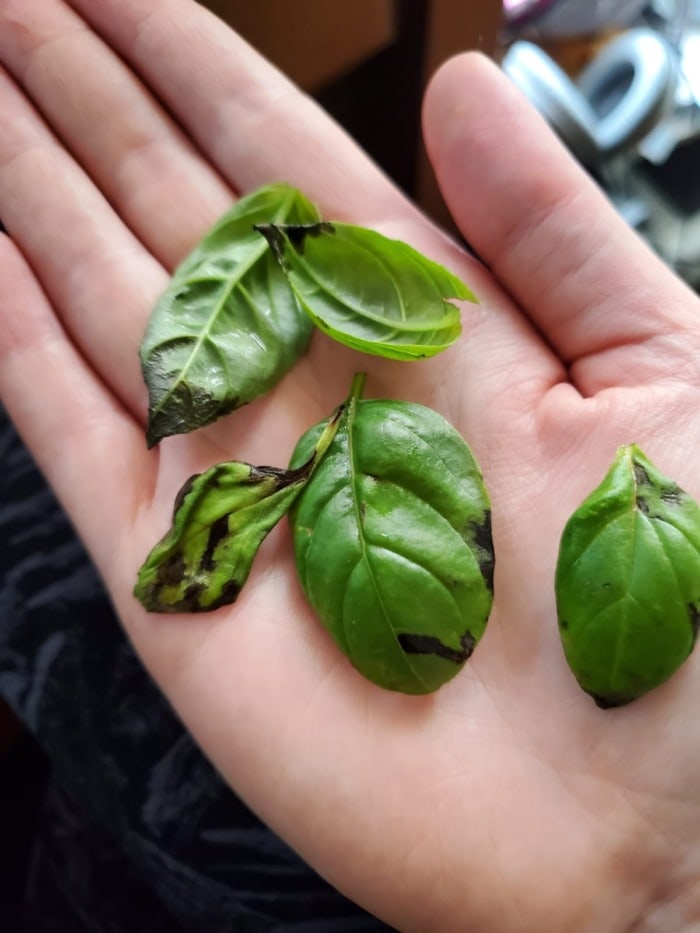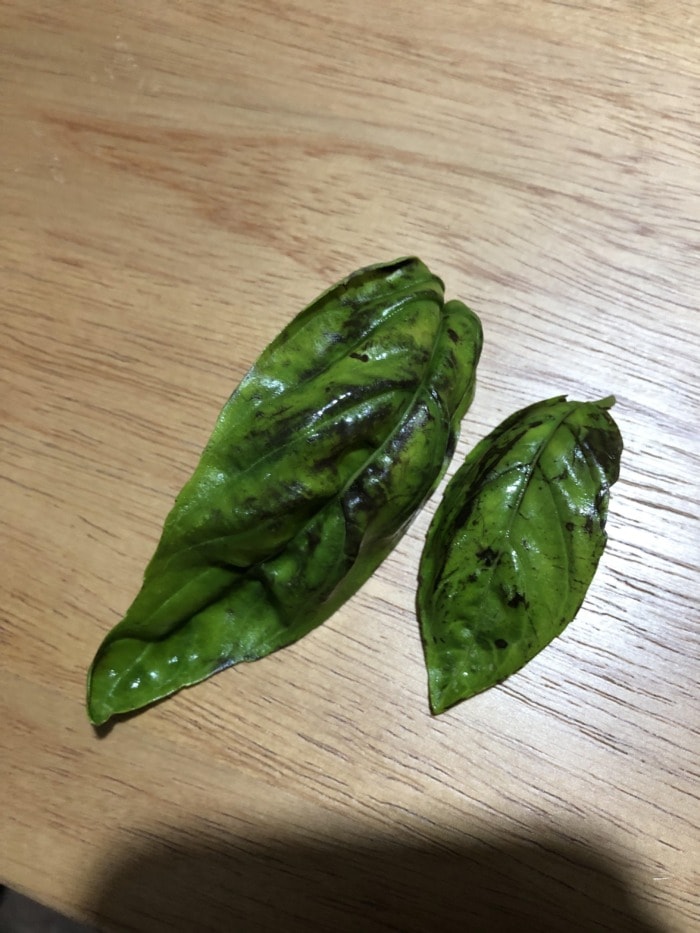Cooking fresh herbs can oftentimes be challenging due to their delicate texture. Basil in particular easily turns black when its leaves are not handled properly.
This typically happens when the leaves get washed, cut or stored in the refrigerator.
Fortunately, you can prevent this by following a few simple guidelines.

by plaidpeacoat
In this article, I’ll discuss what causes basil to turn black and offer you a few solutions as well.
Reasons why basil turns black after picking
Basil is an annual herb that’s mostly grown in subtropical and temperate regions.
Its leaves have a delicate structure and can develop black or brown spots when they’re exposed to molds, bacterial infections and pests.
However, I’ll focus my attention on the most common reasons that make basil turn black after it enters your kitchen.
I will also provide actionable solutions for each instance.
Cutting
Cutting or chopping basil may seem like a good idea, but it’s something you should avoid doing.
Cutting basil exposes its cells to oxygen which leads to enzymatic browning.
Enzymatic browning is a chemical reaction in which the phenols in basil turn into melanin.
This in turn causes basil leaves to turn black.
Even though enzymatic browning can’t be prevented entirely, it can be slowed down in a few ways.
For one, you can try tearing your basil instead of cutting it when you’re making salads or soups.
Tearing reduces the oxidative stress and keeps the basil fresh for longer.
You should also avoid squashing it or placing it underneath other products as this will lead to bruises.
Bruising essentially leads to the same effects as cutting and will make the leaves become black.
Another way to reduce the effects of enzymatic browning on basil is to use the back-slice technique.
The back-slice is a cutting method that uses backward motions to create fine, small slices with minimal crushing.
If you decide to back-slice basil, you should first stack all of the leaves and roll them into a tight bundle.
Then, you should place the edge of the knife at a low angle and start pulling it backwards without any downward motions.
Remember, the idea is to create small fine slices, without pressing the edge of the knife down.
Lastly, you can use olive oil to keep basil leaves from turning black after cutting.
The olive oil will act as a protective barrier that prevents oxygen from entering the leaves.
To do this, simply coat the basil leaves in olive oil and stack them together.
Once the leaves are stacked, use your fingers to roll them up and cut them with your knife.
When you begin cutting, the edge of the knife will get coated in oil and will apply the oil to fresh cuts.
Temperature fluctuations
Basil is quite sensitive when it comes to temperature.
In order to thrive, it needs to be kept at a temperature above 50°F or 10°C.
Storing it at lower temperatures causes its cells to die off and leads to necrosis.
This is why basil typically turns black when it’s kept in the fridge.
Unfortunately, this means it’s not wise to use basil in something like smoothies made the night before or other foods that use fresh basil but you plan to store for longer.
Despite this, you can still store fresh basil on its own in the fridge for a short while.
To do it, simply wrap its stem in a wet paper towel and partially seal it inside a plastic bag.
The paper towel will prevent the basil from wilting, while the plastic bag will regulate its moisture and slow down decay.
If you decide to store your basil in the fridge, it’s best to keep it somewhere warmer like the door.
Avoid placing it at the bottom shelf or the back of the refrigerator since these parts are the coldest.
I must point out that you shouldn’t expect basil to last fresh for more than 24 hours using this method.
This is why I prefer keeping fresh basil in a jar or a glass of water at room temperature.
This way it can last for up to 7 days before it begins to spoil.
You just need to change the water once every 24 hours.
Having said that, basil can also turn black when it’s cooked at a high temperature.
For this reason, it is usually added as the last ingredient at the end of cooking.
Adding it too soon will not only make it black but also cause it to curl up and lose its flavor.
Washing
Even though this is commonly overlooked, washing basil could also make its leaves turn black.
And I must admit that I’ve made this mistake multiple times in the past before I finally figured out why it happened.
When you wash basil and let it sit it absorbs the excess moisture.
This prevents it from getting enough oxygen from the air and speeds up its decay.
Ever since I discovered this, I’ve been using a paper towel to pat my basil dry after washing it.
I’ve also found out that the leaves with a wet paper towel instead of washing them also prevents black spots.
Is basil still safe to eat when it has black spots and patches?

by Aztronaut11
Despite its unappealing look, basil is rarely bad when it has turned black.
However, before you add it to any of your dishes, you’ll need to determine the cause behind its discoloration.
Sometimes, basil leaves develop black areas due to a bacterial or fungal infection.
In these cases, there’s usually a noticeable slime or a powder that covers the surface of the leaves.
Slimy black basil tastes bad.
If you notice any of these signs, you should discard the basil and get a fresh bunch.
In all other cases, the basil will be safe to eat and can be added to most recipes.
However, it will have a slightly bitter taste so you should avoid using it for salads.
For this reason, I mostly use blackened basil when I’m making soups but not when enhancing a spaghetti sauce, say.
If not slimy, a few small black spots on the leaves are nothing to worry about, and if the black patches are larger you can cut them out and only use the fresh basil mass.
My short recap
Basil is a delicate herb that needs to be handled with care.
Storing it in the fridge, washing it or cutting it can cause it to turn black and ruin its flavor.
The best way to preserve its quality is to store it at room temperature and use alternative cutting techniques.
But even if you find yourself with a bunch of black basil, you can still incorporate it in a sauce or soup.
Just remember to check it for any signs of bacterial or fungal infection.